- GLOBUS CRUCIGER
- See ‘orb’.

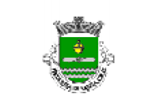
Arms and Flag of Santa Cruz, Portugal (S้rgio Horta)
- GOBONY (GOBONÉ or GOBONATED)
- See ‘compony’.
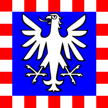
Flag of Tegerfelden, Switzerland (fotw)
- GOD'S EYE
- See ‘eye of God’.
![[God's Eye]](../images/v/vxt-d051a.gif)
![[God's Eye]](../images/v/vxt-d051b.gif)
Arms and Flag of Czernich๓w, Poland
- GOLDEN MEAN (GOLDEN RATIO or GOLDEN SECTION)
- That proportion, first recoded by classical Greek sources, which is considered particularly pleasing
to the human eye; it is the ratio of two values where the relationship of the larger (B) to the smaller
(A) is the same as that of the total (A+B) to the larger (B) and has a value of approximately 1.618 - -
the divine, golden or magic ratio, or golden section.
![[graphic of golden mean]](../images/v/vxt-d155.gif)
Notes
a) Flag ratios are written as hoist:fly, or in this case A:B, which is approximately 1:1.618, however, it is suggested that a mathematical reference work be consulted if further or more complex details are required.
b) Rectangular flags are often made in ratios that approximate the golden mean, e.g. those of successive Fibronacci numbers - 1;1, 1:2, 2:3, 3:5, 5;8, 8:13 etc. with those later in the this listed series being closer to the ideal.
- GONFALON (or GONFALONE)
- 1) The term for a usually long (sometimes elaborate) flag designed to be
hung vertically from a cross bar, often having a shaped and/or fringed bottom
edge or terminating in tails or tongues and characteristic of Italy and of
Central Europe, or of the religious associations in Western Europe where it
might also be called a religious banner (see also
‘banner 2)’,
‘banner 3)’,
‘ceremonial flag 1)’,
‘dexter edge 2)’,
‘sinister edge 2)’,
‘square-tongued’,
‘stepped gonfalon’,
‘tongue(s)’,
‘triangular-ended’
and ‘triangular-ended tails’).
- 2) The term sometimes used for a flag that is designed to be attached both along its hoist to the staff, and
along its top to a side-mounted cross-bar - but see
‘framed flag 2)’ (also ‘ring 4)’).
![[gonfalon]](../images/v/vxt-d159a.gif)
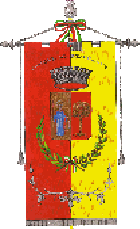
Gonfalon of Asciano Tuscany, Italy (fotw); Gonfalon of Delianuova, Italy (fotw)
Please note – not to be confused with a medieval gonfanon
or with the banner or hanging flag of German speaking and Central European countries (see
also ‘banner 2)’,
‘hanging flag’, and
‘gonfanon’).
- GONFALONI SCALINATI
- See ‘stepped gonfalon’.
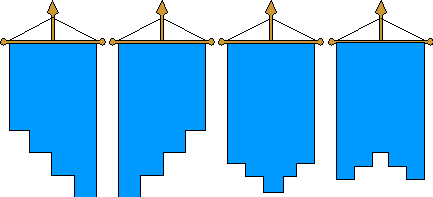
- GONFALONIER
- The bearer of a gonfalon or standard (see also
‘standard bearer’).
- GONFALONIERSHIP
- A term, now largely (if not wholly) obsolete, for the - often hereditary -
honorary office of gonfalonier (standard or flag bearer) to a monarch (see
also ‘archivexillifer’).
- GONFANON
- 1) A war flag of pre-heraldic Europe, often tapered from hoist to fly,
generally attached to a lance and ending in from two to five squared, rounded
or triangular tails - but see note below (also ‘double-tailed descate’,
‘lanceolate’,
‘oriflamme’,
‘pallia’,
‘pre-heraldic’,
‘multi-tailed descate’,
'square-tongued',
‘swallow-tailed(ed)’,
‘swallowtail and tongue’ and
‘triple-tailed descate’).
-
2) See ‘streamer 2)’.
![[gonfanon]](../images/v/vxt-d161.gif)
![[Oriflamme]](../images/v/vxt-d161a.gif)
Gonfanon of Eustache III of Auvergne c1100 (CS); The
Oriflamme of Pre-Heraldic and Medieval France (fotw)
Please note that this term specifically refers to a pre-heraldic European war flag,
and whilst sometimes (inaccurately) used to describe a medieval or late-medieval
streamer (as referenced above), it should not be confused with the later gonfalon,
banner or hanging flag as separately defined herein – see
‘gonfalon’,
‘banner of arms’ and
‘hanging flag’.
- GONTFANONARIUS (or GONFAGONIER)
- A medieval term, now obsolete, for a ‘standard bearer’.
- GORE(S)
- The generic term for a tapering piece or pieces of fabric that is sometimes used to describe
the triangular blue fields of the British union jack (see also
‘union flag 1)’,
‘union jack 1)’ and
‘union jack 2)’).
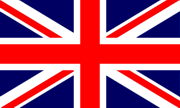
Commander in Chief in the Field Army, UK (fotw)
- GORGED
- The heraldic term used when a beast or bird (and occasionally another charge) is shown with its collar in a
different tincture - this may be either plain or decorated and is sometimes in the form of a coronet – collared
or accolé (see also
‘appendix V’,
‘armed 2)’,
‘attired’,
‘beaked’,
‘jelloped’,
‘langued’,
‘membered’ and
‘tincture’).
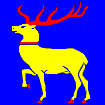

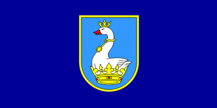
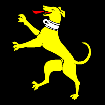
Flag of Oland, Sweden (fotw); Arms of Posedarje, Croatia (fotw); Flag of Combremont-le-Grand, Switzerland (fotw)
- GOTHIC (GOTHIC-STYLE or SHAPED) SHIELD
- The term sometimes used in vexillology to describe a shield which is straight-sided through
part of its depth, and whose lower section consists of convex arcs that comes to a
point at the base – but see note below (also
French shield,
Italian shield,
ogival,
‘rectangular shield’,
‘shield 2)’, Spanish-style shield’
and triarched triangular shield).

Please note that the terms gothic and late-gothic appear to be used indiscriminately
to describe either a pointed or a round-bottomed shield, and the Editors suggest
therefore, that, if used at all, both these terms should be restricted to the type illustrated above.
- GOUTTES (GOUTÉ or GOUTTY)
- The heraldic term for a number of charges (usually specified) in the shape of a teardrop – gutté, gutty,
goutty, gouté or larmes.
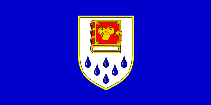

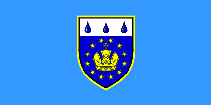

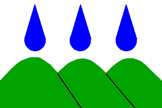
Flag and Arms of Bistra, Croatia (fotw); Flag and Arms of
Tuhelj, Croatia (fotw);
Flag of Destne v Orlických horách, Czech Republic (fotw)
Please note that this term may be variously used dependent upon the tincture,
and we suggest that a suitable glossary or dictionary of heraldry be consulted for full details.
- GOVERNMENT EMBLEM
- See emblem, military or governmental/departmental under emblem.
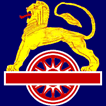
Emblem of British Railways 1949 1965 (fotw)
- GOVERNMENT ENSIGN
- See under ‘ensign’.
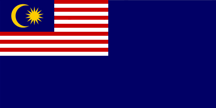
Government Ensign of Malaysia (fotw)
- GOVERNMENT (or GOVERNMENTAL) FLAG
- See ‘state flag 1)’.
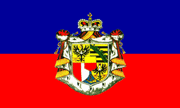
Government Flag of Liechtenstein (fotw)
- GOVERNMENT SERVICE JACK
- See ‘jack’.
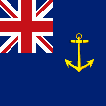
Jack of the Royal Fleet Auxiliary, UK (Martin Grieve)
Introduction | Table of Contents
| Index of Terms | Previous Page | Next Page

![[God's Eye]](../images/v/vxt-d051a.gif)
![[God's Eye]](../images/v/vxt-d051b.gif)
![[gonfalon]](../images/v/vxt-d159a.gif)

![[gonfanon]](../images/v/vxt-d161.gif)
![[Oriflamme]](../images/v/vxt-d161a.gif)















![[graphic of golden mean]](../images/v/vxt-d155.gif)



